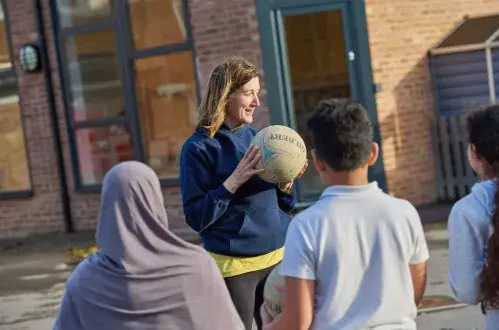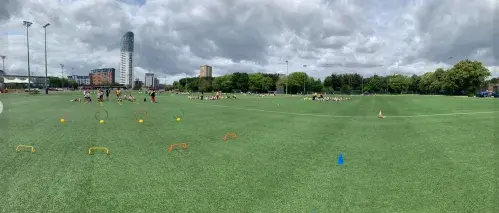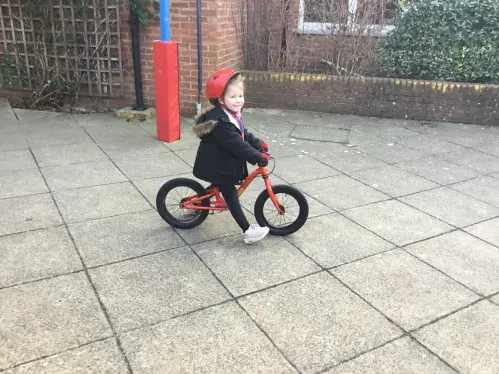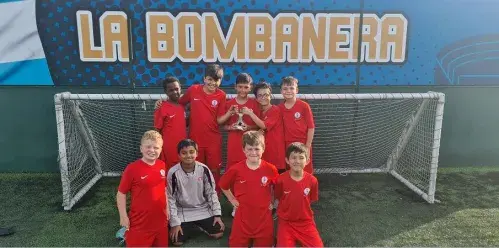Image

Why do we learn physical education?
At Ayrton we believe a child, who is successful in PE will:
- know how to lead a healthy and active life.
- have the skills and knowledge to be competent in a wide range of physical activities.
- be physically active every day.
- have the skills to keep themselves safe in water.
- take part in sporting competitions.
- work well as part of a team, understanding how to play fairly and cooperate with others.
- develop a life-long love of physical activity.
Our approach
Implementation
Our PE curriculum:
- is taught twice weekly by the class teacher, covering a wide range of physical activities.
- is differentiated to be accessible for all children, including children with SEND.
- children are given opportunities at break and lunch time to take part in a range of physically active games and activities.
- children in Years 5 and 6 are taught to swim and keep themselves safe in water.
- children are given the opportunity, and are encouraged, to take part in a range of after-school activities, where they can play competitively against other teams.
- Year 6 children are given the chance to become Sports Leaders, supporting teachers and leading lunchtime activities.
Impact
Through our PE curriculum, children will:
- take part in a wide range of physical activity.
- have the fundamental skills to play an active role in physical activities.
- understand how to live healthy lifestyle and understand the importance of regular exercise.
- will understand the important of fair play and being a good sportsperson.
Enrichment
In addition to the PE curriculum, enrichment is offered through:
- taking part in competitions with other schools.
- activities at play time and lunch times.
- a range of after school activities.
Curriculum Overview
Reception
| Autumn | |
|---|---|
| Progress towards a more fluent style of moving, with developing control and grace. |
| Spring | |
|---|---|
| Develop their small motor skills so that they can use a range of tools competently, safely and confidently. |
| Summer | |
|---|---|
| Use their core muscle strength to achieve a good posture when sitting at a table or sitting on the floor. |
Year 1
| Autumn | |
|---|---|
| To master basic movements including running, jumping, throwing and catching, as well as developing balance, agility and co-ordination, and begin to apply these in a range of activities. To perform dances using simple movement patterns. To participate in team games, developing simple tactics for attacking and defending. |
| Spring | |
|---|---|
| To master basic movements including running, jumping, throwing and catching, as well as developing balance, agility and co-ordination, and begin to apply these in a range of activities. To participate in team games, developing simple tactics for attacking and defending. |
| Summer | |
|---|---|
| To master basic movements including running, jumping, throwing and catching, as well as developing balance, agility and co-ordination, and begin to apply these in a range of activities. To participate in team games, developing simple tactics for attacking and defending. |
Year 2
| Autumn | |
|---|---|
| To master basic movements including running, jumping, throwing and catching, as well as developing balance, agility and co-ordination, and begin to apply these in a range of activities. To perform dances using simple movement patterns. To participate in team games, developing simple tactics for attacking and defending. |
| Spring | |
|---|---|
| To master basic movements including running, jumping, throwing and catching, as well as developing balance, agility and co-ordination, and begin to apply these in a range of activities. To participate in team games, developing simple tactics for attacking and defending. |
| Summer | |
|---|---|
| To master basic movements including running, jumping, throwing and catching, as well as developing balance, agility and co-ordination, and begin to apply these in a range of activities. To participate in team games, developing simple tactics for attacking and defending. |
Year 3
| Autumn | |
|---|---|
| To use running, jumping, throwing and catching in isolation and in combination. To play competitive games, modified where appropriate [for example, badminton, basketball, cricket, football, hockey, netball, rounders and tennis], and apply basic principles suitable for attacking and defending. To perform dances using a range of movement patterns compare their performances with previous ones and demonstrate improvement to achieve their personal best. |
| Spring | |
|---|---|
| To use running, jumping, throwing and catching in isolation and in combination. To play competitive games, modified where appropriate [for example, badminton, basketball, cricket, football, hockey, netball, rounders and tennis], and apply basic principles suitable for attacking and defending. To compare their performances with previous ones and demonstrate improvement to achieve their personal best. |
| Summer | |
|---|---|
| To use running, jumping, throwing and catching in isolation and in combination To play competitive games, modified where appropriate [for example, badminton, basketball, cricket, football, hockey, netball, rounders and tennis], and apply basic principles suitable for attacking and defending. To develop flexibility, strength, technique, control and balance [for example, through athletics and gymnastics]. To compare their performances with previous ones and demonstrate improvement to achieve their personal best. |
Year 4
| Autumn | |
|---|---|
| To use running, jumping, throwing and catching in isolation and in combination. To play competitive games, modified where appropriate [for example, badminton, basketball, cricket, football, hockey, netball, rounders and tennis], and apply basic principles suitable for attacking and defending. To perform dances using a range of movement patterns. To compare their performances with previous ones and demonstrate improvement to achieve their personal best. |
| Spring | |
|---|---|
| To use running, jumping, throwing and catching in isolation and in combination. To play competitive games, modified where appropriate [for example, badminton, basketball, cricket, football, hockey, netball, rounders and tennis], and apply basic principles suitable for attacking and defending To compare their performances with previous ones and demonstrate improvement to achieve their personal best. |
| Summer | |
|---|---|
| To use running, jumping, throwing and catching in isolation and in combination. To competitive games, modified where appropriate [for example, badminton, basketball, cricket, football, hockey, netball, rounders and tennis], and apply basic principles suitable for attacking and defending. To develop flexibility, strength, technique, control and balance [for example, through athletics and gymnastics]. To compare their performances with previous ones and demonstrate improvement to achieve their personal best. |
Year 5
| Autumn | |
|---|---|
| To use running, jumping, throwing and catching in isolation and in combination. To play competitive games, modified where appropriate [for example, badminton, basketball, cricket, football, hockey, netball, rounders and tennis], and apply basic principles suitable for attacking and defending. To compare their performances with previous ones and demonstrate improvement to achieve their personal best. |
| Spring | |
|---|---|
| To use running, jumping, throwing and catching in isolation and in combination. To play competitive games, modified where appropriate [for example, badminton, basketball, cricket, football, hockey, netball, rounders and tennis], and apply basic principles suitable for attacking and defending To perform dances using a range of movement patterns To compare their performances with previous ones and demonstrate improvement to achieve their personal best. |
| Summer | |
|---|---|
| To use running, jumping, throwing and catching in isolation and in combination. To play competitive games, modified where appropriate [for example, badminton, basketball, cricket, football, hockey, netball, rounders and tennis], and apply basic principles suitable for attacking and defending. To develop flexibility, strength, technique, control and balance [for example, through athletics and gymnastics]. To compare their performances with previous ones and demonstrate improvement to achieve their personal best. |
Year 6
| Autumn | |
|---|---|
| To use running, jumping, throwing and catching in isolation and in combination. To play competitive games, modified where appropriate [for example, badminton, basketball, cricket, football, hockey, netball, rounders and tennis], and apply basic principles suitable for attacking and defending. To compare their performances with previous ones and demonstrate improvement to achieve their personal best. |
| Spring | |
|---|---|
| To use running, jumping, throwing and catching in isolation and in combination. To play competitive games, modified where appropriate [for example, badminton, basketball, cricket, football, hockey, netball, rounders and tennis], and apply basic principles suitable for attacking and defending. To develop flexibility, strength, technique, control and balance [for example, through athletics and gymnastics]. To perform dances using a range of movement patterns. To compare their performances with previous ones and demonstrate improvement to achieve their personal best. |
| Summer | |
|---|---|
| To use running, jumping, throwing and catching in isolation and in combination. To play competitive games, modified where appropriate [for example, badminton, basketball, cricket, football, hockey, netball, rounders and tennis], and apply basic principles suitable for attacking and defending. To develop flexibility, strength, technique, control and balance [for example, through athletics and gymnastics]. To compare their performances with previous ones and demonstrate improvement to achieve their personal best. |
Sports News
Image

Sports Day 2024!
This year Sports Day for Years 1-6 took place at the HMS Temeraire playing fields. Although a bit windy, the rain held off and the children did the school proud by playing fair and embodying Ayrton's key characteristics for the afternoon's events. A big thank you to all the parents who came to support the children.


